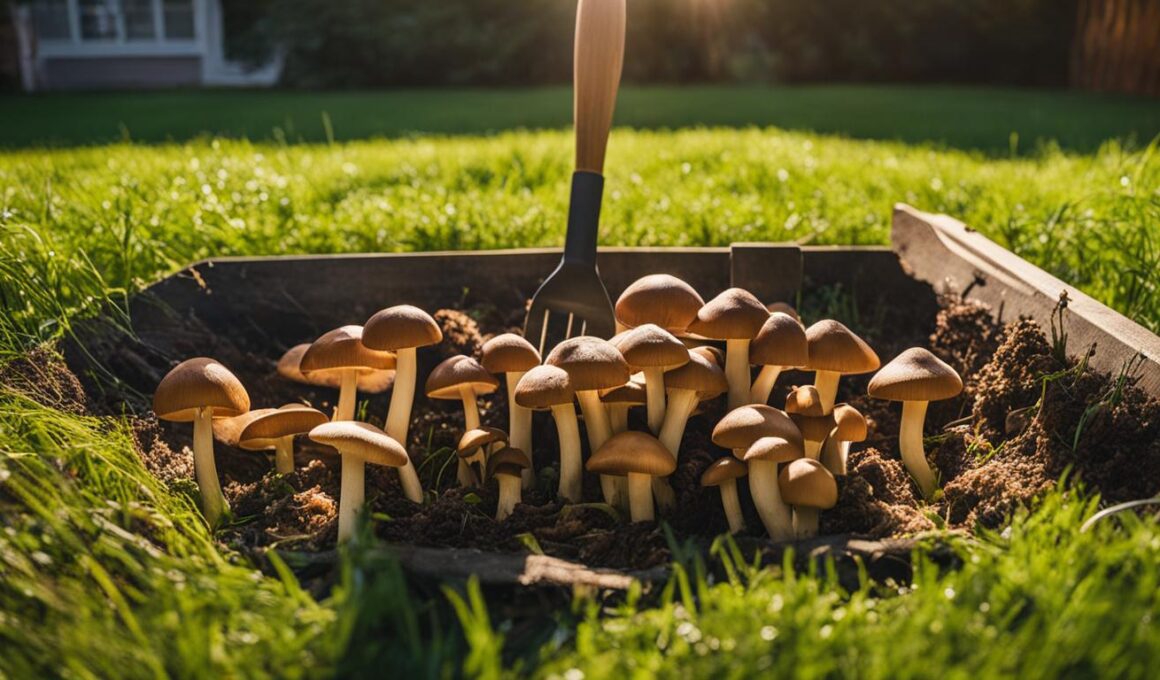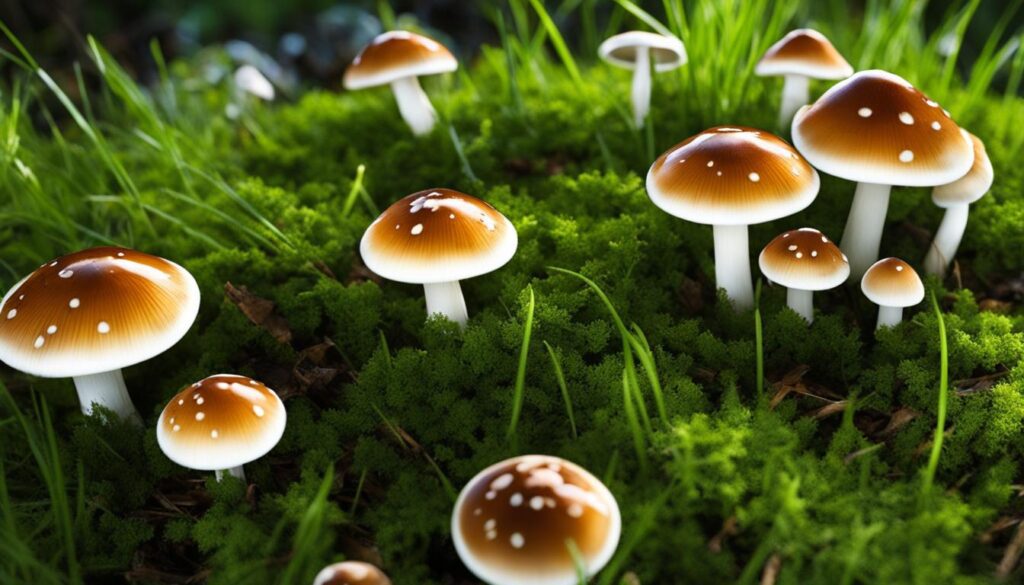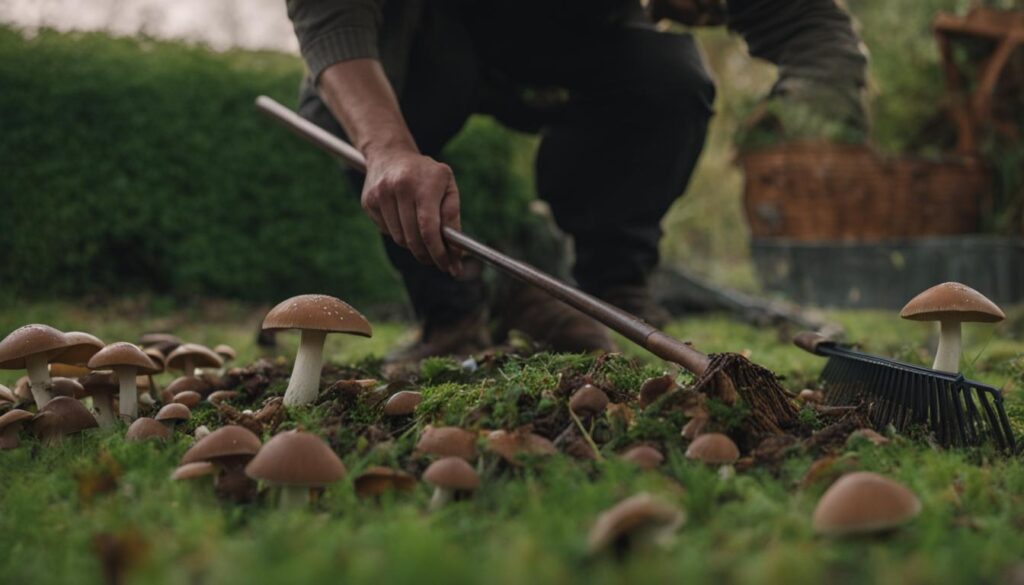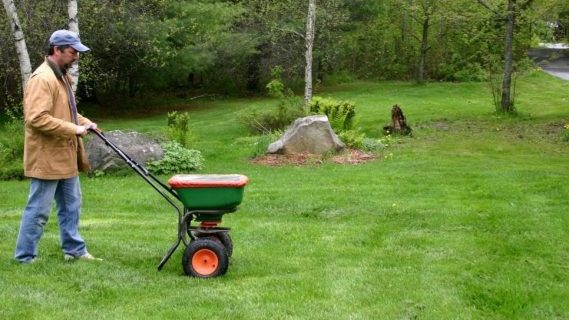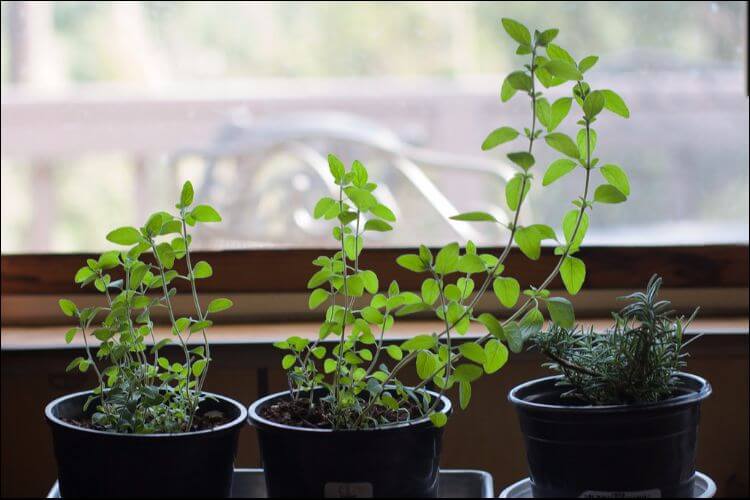Unsightly lawn mushrooms are a common problem that many homeowners face, and while they can be an indicator of healthy soil, they may also pose potential dangers. With the right approach to garden fungi control and lawn care, you can achieve effective lawn mushrooms removal and prevention. In this comprehensive guide, we will explore the causes and consequences of mushroom growth, as well as practical strategies for getting rid of mushrooms in your yard and maintaining a fungi-free lawn.
Key Takeaways
- Understanding the causes and growth conditions of lawn mushrooms is crucial for effective removal and prevention.
- Some mushrooms can be toxic to pets and children, and certain fungi can cause lawn diseases.
- Identifying common lawn mushrooms can help you safely remove them and avoid potential hazards.
- Implementing proper lawn watering practices and maintaining soil health are important preventative measures against mushroom growth.
- Natural and chemical solutions, such as homemade and commercial fungicides, can also be used for mushroom control.
Understanding Why Mushrooms Appear in Your Yard
Mushrooms appear in your yard due to various factors that create favorable growth conditions. These factors help you better understand the causes of lawn mushrooms and how to manage yard fungi growth. To successfully prevent or eliminate these fungi, it is essential to first grasp the mushroom growth conditions that lead to their proliferation.
Some common factors that promote mushroom growth in your yard include:
- Excess moisture from heavy rains or poor drainage
- Warm weather conditions
- Presence of organic matter such as tree stumps, fallen leaves, grass clippings, and animal waste
- Condensed shade that limits available sunlight
Furthermore, mushrooms are a visible sign of a healthy microbial ecosystem in your garden. They thrive in areas rich in decaying organic matter, playing a crucial role in breaking down this waste and recycling nutrients back into the soil. This process supports the growth of other plants and contributes to a balanced soil ecosystem.
A better understanding of the causes and conditions promoting lawn mushrooms’ growth allows for a more effective approach to managing them. By recognizing and addressing these factors, you can maintain a healthy and attractive lawn free of unwanted fungi.
The Potential Risks of Yard Mushrooms to Pets and Kids
While some lawn mushrooms are harmless, certain types can be poisonous mushrooms, posing a serious threat to the safety of your household. Accidental ingestion of toxic mushrooms can lead to severe health complications, given that children and pets are naturally curious and may be drawn to eat them. Ensuring lawn safety, as well as pet and child hazard prevention, is crucial in maintaining a safe environment outdoors.
Another concern is that certain fungi can cause lawn diseases such as brown patch and large patch. Although these diseases do not typically present mushrooms, they can negatively impact the health and appearance of a lawn by creating unsightly bare spots.
Risks Associated with Poisonous Mushrooms
- Health complications: Ingesting toxic mushrooms might cause damage to the liver, leading to kidney and gastrointestinal problems, and can even be fatal in extreme cases.
- Allergic reactions: Some people and animals may have allergic reactions to certain fungi, causing symptoms like hives, itching, and swelling.
- Lawn damage: Certain fungal species may contribute to the development of lawn diseases, which weaken the grass and create unsightly bare patches.
Ways to Keep Your Yard Safe from Hazardous Mushrooms
- Regularly inspect and remove mushrooms from your lawn. Dispose of them safely to avoid the spread of spores.
- Keep a watchful eye on your children and pets when they are playing outside.
- Familiarize yourself with the common poisonous mushrooms in your region and take proactive measures to remove them from your yard.
Signs of Mushroom Poisoning in Humans and Pets
| Signs in Humans | Signs in Pets |
|---|---|
| Nausea and vomiting | Vomiting |
| Diarrhea | Diarrhea |
| Abdominal pain | Abdominal pain (displayed as whining or restlessness) |
| Dizziness and disorientation | Weakness and lethargy |
| Tremors and seizures | Tremors and seizures |
| Irregular heartbeat | Increased or irregular heart rate |
| Difficulty breathing | Difficulty breathing |
If you suspect that your child or pet has ingested a poisonous mushroom, seek immediate medical or veterinary attention. Prompt action can be vital in preventing severe consequences and ensuring their safety.
Identifying Common Lawn Mushrooms
Mushrooms, as a visible part of lawn fungi, vary in shape, size, and color, with over 10,000 known species. They might appear spherical or elongated, with caps in colors ranging from brown and white to vibrant hues. To successfully manage and control common yard mushrooms, it is essential to understand their characteristics and identify potentially toxic varieties.
Characteristics of Regular Yard Mushrooms
There are several non-toxic mushrooms commonly found in lawns as well as toxic varieties. Some popular non-toxic species include field mushrooms and shaggy mane mushrooms. Here are some characteristics to help you identify these common yard mushrooms:
| Mushroom Variety | Cap Shape | Color | Gill Formation |
|---|---|---|---|
| Field Mushroom | Spherical to convex | White to light brown | Crowded white gills |
| Shaggy Mane Mushroom | Cylindrical to bell-shaped | White with brownish scales | Free white gills |
Toxic Varieties to Watch Out For
Highly toxic mushrooms such as the death cap pose significant risks and should be identified and removed immediately. They can be recognized by their distinctive appearance and sometimes odor, differentiating them from edible varieties. Here are some characteristics to help you identify the dangerous death cap mushroom:
| Mushroom Variety | Cap Shape | Color | Gill Formation |
|---|---|---|---|
| Death Cap Mushroom | Convex to flat | Greenish to yellowish | Crowded white gills |
By developing an understanding of common yard mushrooms, fungus identification becomes easier, enabling you to manage your lawn effectively and ensure the safety of children and pets from toxic varieties.
Effective Techniques for Removing Mushrooms from Your Lawn
When it comes to eradicating lawn mushrooms, employing safe removal strategies is essential. Here are some effective mushroom removal methods to help you maintain a healthy and attractive lawn:
- Manual picking
- Mowing
- Secure disposal
Manual Picking:
One of the simplest ways to address lawn mushrooms is by manually picking them. Remember to wear gloves while handling mushrooms to protect your skin from potential toxins. Once picked, dispose of the mushrooms in a sealed bag or container.
Mowing:
Another method of mushroom removal is mowing over them. This approach works best when the mushrooms are small and sporadic. Be sure to collect and bag the debris, as it contains spores that may give rise to new mushrooms.
Proper disposal of mushrooms is crucial to prevent the spread of spores. Dispose of the mushrooms in a sealed bag or container and place it in your trash to avoid reintroducing the fungi into your lawn or garden.
Natural Dissipation Under Sunlight and Dry Conditions
Occasionally, mushrooms will naturally dissipate under the right conditions. When exposed to sunlight and dry conditions, the mushrooms will lose moisture and shrink, eventually disappearing. Be patient and monitor your lawn, ensuring that no new mushrooms emerge as the existing ones vanish.
| Removal Method | Quick Description | Benefits | Drawbacks |
|---|---|---|---|
| Manual Picking | Use gloves to pick mushrooms and dispose of them in a sealed bag/container. | Immediate removal and control over affected areas. | Can be time-consuming if dealing with a large number of mushrooms. |
| Mowing | Mow over mushrooms and collect the debris. | Efficient way to remove small and sporadic mushrooms. | Spores may spread if debris is not collected properly. |
| Secure Disposal | Place mushrooms in a sealed bag or container and dispose of in trash. | Prevents the spread of spores. | None. |
| Natural Dissipation | Allow sunlight and dry conditions to cause mushrooms to shrink and vanish. | No manual labor involved. | Takes time, mushrooms may reappear if underlying conditions persist. |
Remember that the key to success in removing lawn mushrooms lies in employing safe and effective eradication methods. With proper care and attention, your lawn will become a fungi-free zone, allowing you to maintain a beautiful and healthy outdoor space.
Preventative Measures to Discourage Mushroom Growth
Preventing fungal proliferation in your lawn requires creating unfavorable growth conditions, which include proper lawn watering, maintaining soil health and drainage, and yard sanitation. These mushroom prevention strategies lead to a healthy, visually appealing lawn while minimizing the chances of fungi spreading.
Proper Lawn Watering Practices
Smart lawn watering is one of the most effective lawn care tips for preventing the growth of fungi. To strike the ideal balance, ensure that your lawn receives about 1 inch of water per week without promoting excess moisture, which might encourage fungal growth. Water your lawn in the morning, allowing it to dry before the sun sets. This prevents standing water and helps reduce the likelihood of mushrooms appearing on your lawn.
- Water deeply but infrequently to minimize excess moisture.
- Focus on providing 1 inch of water per week.
- Water in the morning for optimal lawn drying.
Maintaining Soil Health and Drainage
Optimal soil health and efficient drainage are critical factors in the prevention of mushroom growth. Aeration, which involves creating small holes or channels in the soil, is a necessary practice for improving air circulation and promoting soil health. Additionally, the removal of thatch – the layer of dead and living plant materials that accumulates above the soil in your lawn – helps to improve drainage and discourages mushroom proliferation.
Consistent yard sanitation is another vital aspect of maintaining a healthy lawn. Regularly clear plant waste such as grass clippings, fallen leaves, tree stumps, and animal waste to avoid creating an environment conducive to mushroom growth. These simple preventative measures can make a significant difference in preventing the appearance and spread of mushrooms in your yard.
| Soil Health and Drainage Techniques | Benefits |
|---|---|
| Soil aeration | Improves air circulation and soil health |
| Thatch removal | Enhances soil drainage and discourages mushroom growth |
| Yard sanitation | Prevents the accumulation of organic waste that promotes fungi proliferation |
Natural and Chemical Solutions for Mushroom Control
Aside from manual removal and prevention methods, there are natural and chemical solutions available that can help control lawn mushrooms effectively. While both options aim to address the mushroom issue without causing harm to the rest of your lawn, they typically only treat the visible part of the fungus.
Natural fungicides are perfect for those who prefer eco-friendly remedies. They are easy to prepare at home using readily available ingredients that don’t pose any harmful side effects on your lawn, pets, or the environment. Some popular and effective natural fungicides include:
- Vinegar mixtures: A solution of equal parts water and white vinegar can be sprayed on visible mushrooms and the surrounding area for a safe and natural control method.
- Diluted baking soda: Mixing one tablespoon of baking soda into a gallon of water creates a mild fungicide that can help deter mushrooms from growing.
On the other hand, chemical treatments are the go-to solution if you want to eliminate mushrooms more aggressively. However, caution must be exercised when using chemical treatments to ensure that they do not adversely affect the rest of your garden or pose any harm to children and pets. Some well-known commercial chemical treatments include:
- Fungicides designed for lawn applications: These products are specially formulated to target lawn fungi and can be found at most garden supply stores.
- Systemic lawn fungicides: These are absorbed by the grass and translocated throughout the plant, providing protection against a wide range of lawn diseases, including fungal growth.
It’s essential to note that chemical solutions should be used as a last resort or when natural remedies prove to be ineffective. To ensure a safe and effective application, follow the product label instructions closely and consult with a professional lawn care expert if necessary.
Remember, while both natural and chemical approaches can effectively control lawn mushrooms, they tend to only deal with the visible part of the problem. Combining these treatments with manual removal and prevention methods will yield the best results for maintaining a healthy, fungus-free lawn.
Can Grass Clippings Cause Lawn Mushrooms to Grow?
Leaving grass clippings on the lawn after mowing can lead to the growth of unsightly and potentially hazardous mushrooms. To avoid this, environmentally friendly grass clippings disposal methods, such as composting or mulching, can be used to prevent the development of lawn mushrooms.
Conclusion
Lawn mushroom management is essential for maintaining a healthy, beautiful, and fungus-free lawn. Understanding the growth conditions of mushrooms and effectively addressing them can significantly reduce their proliferation on your property. As a homeowner, it’s important to adopt best practices in lawn care to protect your yard from unwanted fungi.
Safely removing existing mushrooms through manual extraction and mowing, as well as adopting preventative measures to create unfavorable growth conditions, are crucial in preventing further issues. Improving soil health, smart watering, and thorough yard sanitation are key factors in promoting overall lawn health and preventing future mushroom growth.
Whether you choose to use natural or chemical solutions to control mushrooms, it’s essential to consider the safety and impact of these treatments on your lawn. By diligently employing these strategies and lawn care best practices, you can successfully maintain a vibrant and fungus-free lawn for you and your family to enjoy.





